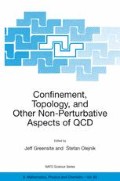Abstract
We perform a lattice analysis of the Faddeev-Niemi effective action conjectured to describe the low energy sector of SU (2) Yang-Mills theory. To this end we generate an ensemble of unit color vectors n from the Wilson action. The construction is such that the ensemble does not show long-range order but exhibits a mass gap of the order of 1 GeV. A study of exact lattice Schwinger-Dyson and Ward identities indicates that the generated ensemble cannot be described by the Faddeev-Niemi effective action or simple generalizations thereof.
Access this chapter
Tax calculation will be finalised at checkout
Purchases are for personal use only
Preview
Unable to display preview. Download preview PDF.
References
Baker, M., J. S. Ball, and F. Zachariasen (1983) ‘An effective action describing long range Yang-Mills theory’. Nucl. Phys. B229, 445.
Battye, R. and P. Sutcliffe (1998) ‘Knots as stable soliton solutions in a three-dimensional classical field theory’. Phys. Rev. Lett. 81, 4798.
Davies, C., G. Batrouni, G. Katz, A. Kronfeld, G. Lepage, K. Wilson, P. Rossi, and B. Svetitsky (1988) ‘Fourier acceleration in lattice gauge theories. 1. Landau gauge fixing’. Phys. Rev. D37, 1581.
Faddeev, L. and A. Niemi (1997) ‘Knots and particles’. Nature 387, 58.
Faddeev, L. and A. Niemi (1999) ‘Partially dual variables in SU(2) Yang-Mills theory’. Phys. Rev. Lett. 82, 1624.
Falcioni, M., G. Martinelli, M. Paciello, G. Parisi, and B. Taglienti (1986) ‘A new proposal for the determination of the renormalization group trajectories by Monte Carlo renormalization group method’. Nucl. Phys. B265, 187.
Gies, H. (2001) ‘Wilsonian effective action for SU(2) Yang-Mills theory with Cho-Faddeev-Niemi-Shabanov decomposition’. Phys. Rev. D63, 125023.
Gonzalez-Arroyo, A. and M. Okawa (1987) ‘Renormalized coupling constants by Monte Carlo methods’. Phys. Rev. D 35, 672.
Koma, Y., H. Suganuma, and H. Toki (1999) ‘Flux tube ring and glueball properties in the dual Ginzburg-Landau theory’. Phys. Rev. D60, 074024.
Kronfeld, A. S.M. L. Laursen, G. Schierholz, and U.-J. Wiese (1987) ‘Monopole condensation and color confinement’. Phys. Lett B198, 516.
Maedan, S. and T. Suzuki (1989) ‘An infrared effective theory of quark confinement based on monopole condensation’. Prog. Theor. Phys. 81, 229–240.
Mandelstam, S. (1976) ‘Vortices and quark confinement in non-Abelian gauge theories’. Phys. Rep. 23, 245.
Polyakov, A. (1987) Gauge Fields and Strings. Harwood Academic, Chur.
Polyakov, A. M. (1975) ‘Compact gauge fields and the infrared catastrophe’. Phys. Lett. B59, 82–84.
Polyakov, A. M. (1977) ‘Quark confinement and topology of gauge groups’. Nucl. Phys. B120, 429–458.
Seiberg, N. and E. Witten (1994) ‘Electric-magnetic duality, monopole condensation, and confinement in N=2 supersymmetric Yang-Mills theory’. Nucl. Phys. B426, 19–52.
Shabanov, S. (1999) ‘Yang-Mills theory as an Abelian theory without gauge fixing’. Phys. Lett. B463, 263.
't Hooft, G. (1976) ‘Gauge theories with unified weak, electromagnetic and strong interactions’, in: High Energy Physics, Proceedings of the EPS International Conference, Palermo 1975, A. Zichichi, ed., Editrice Compositori, Bologna 1976.
't Hooft, G. (1981) ‘Topology of the gauge condition and new confinement phases in non-Abelian gauge theories’. Nucl. Phys. B190, 455.
Teper, M. J. (1998) ‘Glueball masses and other physical properties of SU(N) gauge theories in D = 3+1: A review of lattice results for theorists’, hep-th/9812187.
van Baal, P. and A. Wipf (2001) ‘Classical gauge vacua as knots’. Phys. Lett. B515, 181–184.
Author information
Authors and Affiliations
Editor information
Editors and Affiliations
Rights and permissions
Copyright information
© 2002 Springer Science+Business Media Dordrecht
About this chapter
Cite this chapter
Dittmann, L., Heinzl, T., Wipf, A. (2002). An Effective Theory for the SU(2) Mass Gap?. In: Greensite, J., Olejník, Š. (eds) Confinement, Topology, and Other Non-Perturbative Aspects of QCD. NATO Science Series, vol 83. Springer, Dordrecht. https://doi.org/10.1007/978-94-010-0502-9_9
Download citation
DOI: https://doi.org/10.1007/978-94-010-0502-9_9
Publisher Name: Springer, Dordrecht
Print ISBN: 978-1-4020-0874-0
Online ISBN: 978-94-010-0502-9
eBook Packages: Springer Book Archive

